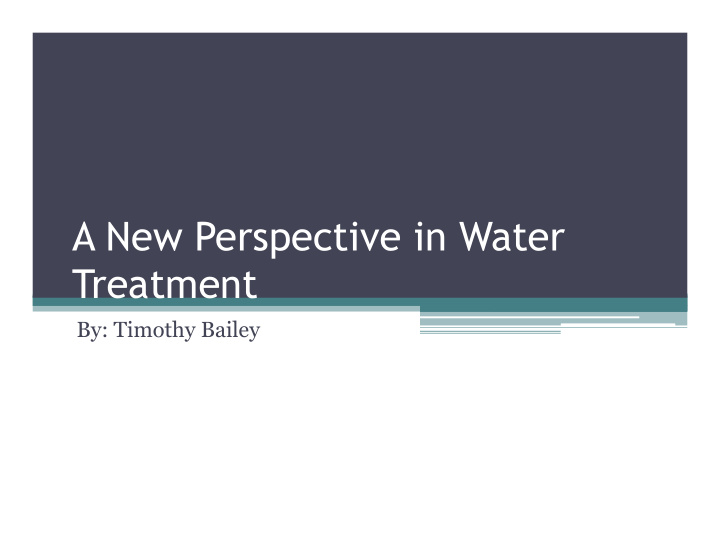



A New Perspective in Water Treatment By: Timothy Bailey
Introduction � 40 MGD Conventional Treatment Plant � Lake Hodges � San Dieguito Reservoir � San Diego County Aqueduct
North No Scale Feb 2008 R.E. Badger Filtration Plant
SDR Raw Water Pipeline I m p o r t e d W a t e r A q u e d u c Treated Water t s to SFID/SDWD LH - Raw Water Pipeline Hydroplant CWA Flow Control Sludge Facility Processing Chem. Storage Ops. Bldg. 13 MGD And Filters Clearwell Flocculation and Sedimentation
Challenging Local Sources � High TOC/ DOC � High Manganese � Low DO � Severe Algae Blooms � Fish Kills � Stratification High Cost of Treatment High Disinfection Byproducts
Challenging Local Sources Source TOC (2 Years) 14 12 10 Local 8 mg/l Import 6 4 2 0
Challenging Local Sources Source MIB/ Geosmin 250 200 150 MIB ng/l Geosmin 100 50 0
Challenging Local Sources Source Water Manganese 2 1.8 SDR Manganese 1.6 Lake Hodges Outlet Manganese CWA 1.4 Manganese (mg/L) 1.2 1 0.8 0.6 0.4 0.2 0
110 90 Depth (ft) 70 50 30 0 5 10 15 20 25 30 D.O., pH, Temperature
110 90 Depth (ft) 70 50 30 0 5 10 15 20 25 30 D.O., pH, Temperature
Local Sources Identify the Problems � Algae Blooms � Low Dissolved Oxygen � Lake Turnover � High Nutrient Loading � Fish Kills � High Treatment Cost � High Disinfection Byproducts
Cost of Treatment Total Treatmetn Cost ($/ AF) 1200 100% Treated Imported 1000 800 Cost/ AF 100% Raw Imported 600 400 Blend of Local and Raw Imported 200 100% Local 0 1 2 3 4 5 6 7 8 9 10 11 12 13 14 15 16 17 18 19 20 21 22 23 24 25 26 27 28 29 30 31 Day of Month
DBP Formation is often the limiting factor in the amount of local water that can be used. ¡ ¡ Q1 ¡ Q2 ¡ Q3 ¡ ¡ Q4 ¡ Q1 ¡ Q2 ¡ Q3 ¡ Q4 ¡ Loc ¡1 ¡ 61.0 100.0 58.0 64.0 73.0 110.0 57.0 72.0 Loc ¡2 ¡ 62.0 87.0 60.0 62.0 74.0 110.0 56.0 68.0 Loc ¡3 ¡ 51.0 100.0 59.0 64.0 75.0 110.0 52.0 67.0 Loc ¡4 ¡ 49.0 100.0 59.0 64.0 78.0 120.0 56.0 67.0 Loc ¡5 ¡ 50.0 100.0 58.0 62.0 75.0 110.0 56.0 68.0 ¡ ¡ ¡ ¡ ¡ ¡ ¡ ¡ ¡ ¡ ¡ ¡ ¡ ¡ ¡ ¡ ¡ ¡ Q ¡Avg. ¡ 54.6 ¡ 97.4 ¡ 58.8 ¡ 63.2 ¡ 75.0 ¡ 112.0 ¡ 55.4 ¡ 68.4 ¡ ¡ ¡ ¡ ¡ ¡ ¡ ¡ ¡ ¡ ¡ ¡ ¡ ¡ ¡ ¡ ¡ ¡ ¡ RAA ¡ ¡ ¡ ¡ ¡ ¡ 68.5 73.6 77.3 76.4 77.7
Local Sources Identify the Goals – SDR Only � Improve quality/ Lower DBPs � Reduce the impact from lake Hodges � Lower Treatment Costs � Increase Local Usage
San Dieguito Reservoir Aeration Aeration Diffusers � Seven disks Installed � De-stratify SDR � Three lake turnovers per day
San Dieguito Reservoir Solar Bee Mixer Gentle Vertical Mixing De-stratification Low Maintenance
17 San Dieguito Reservoir Attached Growth Media (Aquamats) � Large surface area � Colonize nitrifying bacteria for removal of organically complexed ammonia species � Low Maintenance � Reduction of available nutrients – Phosphorus and Nitrogen
18 Equipment Placement
19 Equipment Placement
Results Before Management After Management
Percent (%) Results 100% 10% 20% 30% 40% 50% 60% 70% 80% 90% 0% 1/7/2002 5/7/2002 9/7/2002 1/7/2003 5/7/2003 9/7/2003 1/7/2004 5/7/2004 9/7/2004 1/7/2005 5/7/2005 9/7/2005 REB TOC Removal 1/7/2006 5/7/2006 Actual % Removal 9/7/2006 1/7/2007 5/7/2007 9/7/2007 1/7/2008 5/7/2008 9/7/2008 1/7/2009 5/7/2009 9/7/2009 1/7/2010 5/7/2010 9/7/2010 1/7/2011 5/7/2011 9/7/2011 1/7/2012 5/7/2012
Percent (%) Results 100% 10% 20% 30% 40% 50% 60% 70% 80% 90% 0% 1/7/2002 5/7/2002 9/7/2002 1/7/2003 5/7/2003 9/7/2003 1/7/2004 5/7/2004 9/7/2004 1/7/2005 5/7/2005 Local Water Production 9/7/2005 1/7/2006 5/7/2006 % Local Water Used 9/7/2006 1/7/2007 5/7/2007 9/7/2007 1/7/2008 5/7/2008 9/7/2008 1/7/2009 5/7/2009 9/7/2009 1/7/2010 5/7/2010 9/7/2010 1/7/2011 5/7/2011 9/7/2011 1/7/2012 5/7/2012
Disinfection Study � Identify Cl2 application point options � Predict cost savings � More reliable source blends � Prepare for Stage 2 DBPR
Disinfection Study Filters Flash ¡ Mix ¡Se�led Clearwell NH3 Chlorine ¡ Dioxide ¡ Pre-‑oxida�on Free Chlorine
Disinfection Study
Disinfection Study Filters Flash ¡ Mix ¡Se�led Clearwell NH3 Chlorine ¡ Dioxide ¡ Pre-‑oxida�on Free Chlorine
Disinfection Study Total THMS Chlorine Residual 160 18 140 17 Residual Chlorine (mg/l) 120 16 Total THMs (ug/l) 100 15 Influent 80 14 Settled 60 13 40 12 20 11 0 10
Disinfection Study TTHMs 180 160 140 120 1 Test 100 2 ug/l Condition 3 80 4 60 40 20 0
Disinfection Study � 27% Drop in Chlorine Demand ▫ Savings of 20K/year and 77K lbs/year � 40% average reduction in TTHMs � Potential 10% increase of local water usage (with safety factor)
Online Monitoring � AMS THM100 � Online TTHM Analyzer � Samples Effluent water prior to delivery to the district
Online Monitoring � Purge and Trap sample prep � Based on the Fujiwara reaction � Spectrophotometric detection at 540nm
Online Monitoring Grab-sample (Lab) vs. THM-100 Analyzer 100 90 80 70 60 Analyzer THM Grab THM ug/l 50 Analyzer CCl3 40 Grab CCl3 30 20 10 0
Online Monitoring � RSD = 1.2 for TTHM and 2.0 for CHCl3 � 4.07% average difference between ml551.1 and the online analyzer. � Confidence in online readings.
Results � Can maximize the usage of local water with a safety factor based on THM production. � Can track changes in source water as they affect DBP formation. � Able to predict district TTHM values based on average effluent TTHM online values.
Questions ?
Recommend
More recommend